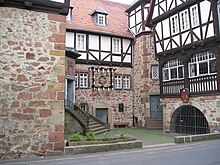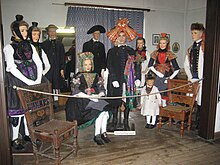Museum of the Schwalm
| Data | |
|---|---|
| place | Schwalmstadt- Goat Grove |
| Art |
historical museum, art museum, folklore
|
| opening | 1927, from 1938 in the stone house |
| management |
Schwälmer Heimatbund eV
|
| Website | |
| ISIL | DE-MUS-123415 |
The Schwalm Museum in the Steinernen Haus on Paradeplatz in Schwalmstadt -Ziegenhain houses a folklore collection on the Schwalm area and the culture of this region. The museum is also dedicated to archeology and the history of the town of Ziegenhain and the surrounding area.
The Schwalm Museum is supported by the Schwalm Heimatbund eV.
History of the museum
Collection activity began in 1911, when Heinrich Schwalm and Harry Heussner collected the first items in conjunction with the Knüllgebirgsverein . This first collection was initially housed in the district office in Ziegenhain. The First World War interrupted activities. It was not until 1920 that the Knüllgebirgsverein was able to continue its activities with the support of the district from Günther von Steinau-Steinrück and Hermann Witkugel. Since the rooms in the district office turned out to be unsuitable, two rooms were rented in a building on Wiederholdstrasse. Finally, on October 13, 1927, the museum opened its doors to the public for the first time. Soon, however, due to lack of space, one had to look around for a new option and the museum moved to the house at Grenzebacher Tor in Muhlystrasse, where a total of six rooms were available. With the acquisition of the Steinerne Haus on June 11, 1938, it made sense to accommodate the museum there. During the Second World War, the stocks were put into storage as the house was used as living space.
With the establishment of the “Schwalm Heimatbund eV” in 1949, the Schwalm Museum found its final sponsor and so it was able to reopen on June 19, 1949, initially with two exhibition rooms. Today the whole building is available to the facility.
building
The so-called "Stone House" originated from the Burgmannensitz of the Lords of Falkenberg acquired in 1363 by Werner II von Falkenberg. It was rebuilt in 1659–61 for the then Ziegenhain fortress commander Jakob von Hoff. It is a three-wing complex with a stair tower. In 1938 the district of Ziegenhain acquired the stone house, and with it the Schwalm Museum found its permanent home.
Departments
Folklore and costume
The Schwälmer costume will be given special attention. Both life-size groups of figures and numerous individual pieces can be used to experience the variety of rural clothing, which is differently designed depending on the occasion and age. This also includes a large selection of Schwalm whitework from three centuries, which can be seen permanently in the exhibition. In the reconstructed pottery workshop, the museum shows the ceramics and pottery used in the region. Tools and Schwalm shoes are presented in a replica shoemaker's workshop. One room is dedicated to flax processing and shows the tools used from the breaker to the loom . The kitchen and bedroom give an impression of the home decor in the Schwalm around 1900.
Water fortress and city history department
Philip the Magnanimous had Ziegenhain expanded into a fortress in 1537–1542. The museum houses a model of the Ziegenhain water fortress , which was recreated according to plans from the 18th century and shows the state of the fortress after the bombardment of 1761. In an adjoining room there are exhibits on the history of the fortress.
Prehistory and early history / geology
In the early history department you can find the collection from the Palaeolithic period of Dr. hc Adolf Luttropp, as well as weapons, tools, devices and ceramics from different cultural epochs that were found in the Ziegenhain district. In the geological collection is u. a. a copy of the Treysa meteorite that fell near Rommershausen in 1916.
literature
- Heinrich Credé: 75 years of the Schwalm Museum , 1986.
- Heinz Reuter: Ziegenhain. History of the city 782-1973 , 3rd edition, Schwalmstadt, 2000.
- Schwälmer Heimatbund eV (Ed.): Schwalm Yearbook 1972 , Schwalmstadt, 1971.
- Schwälmer Heimatbund eV (Ed.): Schwalm Yearbook 2002 , Schwalmstadt, 2001.
Web links
Individual evidence
- ↑ Credé, Heinrich: “75 Years of the Schwalm Museum”, 1986
- ↑ Heinz Reuter: Ziegenhain. History of the city 782-1973, 3rd edition, Ziegenhain, 2000, p. 57.
- ↑ Reuter, Heinz: Ziegenhain. History of the City 782-1973, 3rd edition, 2000, p. 28.
- ↑ Auth, Rudolf: "The Schwälmer Meteoritenfall", in: Schwalm Yearbook 2002, Schwalmstadt, 2001, pp. 135–153.
Coordinates: 50 ° 54 '39.1 " N , 9 ° 14' 4.9" E





